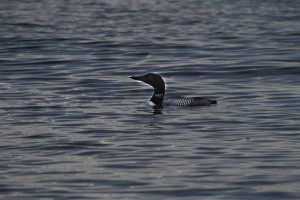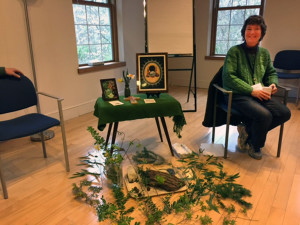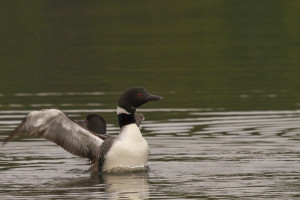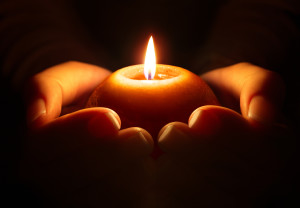Pray the bird

Sometimes I am perfectly capable of scanning large swathes of bad news with aplomb, keeping my feelings at bay. I know how to brace myself before I open the morning paper, turn on the TV, or scan the news online. OK, world, I’m ready! Bring it on! Give me the latest list of apocalyptic woes! I can take it! I can handle it without blinking an eye!
But then comes a story about one small bird.
Researchers have confirmed the first death from malaria of a loon in New Hampshire. As the global climate heats up, diseases of the south, including malaria, are marching north. Although human beings are not susceptible to avian malaria, this tropical disease could have “devastating impacts” on birds with no natural resistance. To find a bird killed by malaria in the northern reaches of New England is a foreboding discovery. As one researcher observed, “This might be a canary in a coal mine situation.”
The metaphor is apt. In the old days coal miners would bring a caged canary into the mine to provide advance warning if dangerous gases like methane or carbon monoxide were building up. A canary is sensitive. A sickened or dead canary warned miners to take action quickly lest they, too, breathe their last. Today the whole world is in “a coal mine situation,” for extracting dirty fuels like coal, gas, and oil is releasing dangerous amounts of greenhouse gases into the atmosphere, disrupting the delicate balance of the climate and threatening the web of life.
A loon is our canary today. News that a loon has died from malaria spread by climate change stops me in my tracks, appalled. I love loons. Summer by summer our family spends a week in New Hampshire beside a lake. Loons’ haunting cries erupt in the night, thrilling and wild. During the day we watch for loons as we paddle our canoes, and if we spot one – precious sight! – we pause to let the boat drift so as not to disturb these shy birds. I am not a scientist, and I can’t describe how loons contribute to the intricate balance of life in the lakes and woods of northern New England nor how their loss would affect the ecosystem, but I do know that losing the loons would somehow empty the lake, leave an aching muteness in the air, and tear a hole in my heart.
I weep for loons.

Can we grieve the losses brought about by a changing climate? I raised that question last week with Episcopal clergy from the Diocese of Delaware when we gathered for a three-day retreat in Pennsylvania at Pendle Hill, a Quaker center for study and contemplation. We talked about how easy it is, in the face of the danger and loss brought on by climate change, to go numb, change the subject, minimize the threat, and find a way to distance and distract ourselves. Most of us don’t challenge outright the science of climate change – we know it’s real, we know that human activities account for most of it, we know it’s already having profound, damaging, and sometimes irreversible effects worldwide. But most of us do engage in a kind of everyday climate denial: we avoid thinking about it. We consider it someone else’s problem. As the Australian ethicist Clive Hamilton points out in Requiem for a Species, we resist the truth about climate change for all kinds of reasons:
“Sometimes facing up to the truth is just too hard. When the facts are distressing it is easier to reframe or ignore them. Around the world only a few have truly faced up to the facts about global warming… It’s the same with our own deaths; we all ‘accept’ that we will die, but it is only when our death is imminent that we confront the true meaning of our mortality.”
When the full truth of the climate crisis finally breaks through our defenses, we experience what one journalist has called the “Oh shit” moment we all must have. Our denial breaks down. We realize that the people we want to ridicule as “alarmists” are conveying news that is both terrifying and true.
I remember exactly where I was when I had my “Oh shit” moment. It was a warm July night in 2002 and I was standing on the edge of Thompson Island, looking out over Boston Harbor. I was deep into an intensive weekend conference on the science and politics of climate change. I had spent the last couple of days jotting down facts about droughts and floods, sea levels and hurricanes, the connection between a warming world and a rise in infectious disease. I’d taken notes on the extreme social disruptions likely to be unleashed by global climate change, on the millions of refugees that would go in search of food and water, on the wars that could erupt over increasingly scarce natural resources.
I had taken in all the facts I could, I had fought valiantly against the temptation to daydream or space out, and now I was reeling. Deeply shaken, I stepped outside into the dark. I stood in silence for a while, breathing the night air. The whole planet seemed to be tilting under the stars, as if the ground were shifting beneath my feet. The old world I’d lived in was gone.
I tried that night to assimilate what I’d heard, to regain my balance, and to find my way back to God. That night I tried to sleep. The next morning I went looking for Paul Epstein, the doctor from Harvard Medical School whose presentation on climate had so overwhelmed me. I carried my breakfast tray to his table and asked if I could have a word with him. I told him how stunned I was by what he had told us.
“How do you bear it?” I asked him. “What do you do with your feelings?”
“I don’t get into my feelings,” he told me. “I focus on what I can do.”
Thus Dr. Epstein taught me one of the options after our denial breaks down: we can get busy and focus on action. His comment reminded me of what labor organizer Joe Hill reportedly said before he died, “Don’t mourn. Organize.” Some of us definitely prefer not to mourn. Most of us, in fact, prefer to engage our painful emotions as little as possible. We lock them away or we leapfrog over them. After all, we don’t want to look morbid, weak, or sentimental. Or we may dodge our feelings for fear of being overcome by anxiety or despair, or of drowning in sorrow. We may fear that experiencing our emotions will become a substitute for action or even sabotage our capacity to act. And you can’t argue with the fact that taking action is essential. In the midst of the battle to protect life as it has evolved on this planet, we do need to act. We do need levelheaded leaders who can say, This is what we must do. Let’s go.
Yet I’m convinced that for the long haul we also need to notice and experience what we feel. Is not grief a way of expressing love? Is not anger a natural response to injustice? Doesn’t learning how to ride the energies of grief and anger in a skillful way bring forth actions more likely to be wise, compassionate, and effective?
By the time that long-ago weekend workshop was over and the ferry was carrying us back to shore, I realized that I had no wish – indeed, no ability – to take action regarding the climate crisis unless I gave myself permission along the way to notice what I was feeling. After all – I’m a recovering addict. Nearly 35 years of recovery have shown me the value of respecting my emotional life: listening inwardly and honoring, even befriending, what I feel prevents me from careening into compulsive and willful behavior.
I was beginning to clarify my own approach to living with what James Howard Kunstler has since called “the long emergency,” that extensive period we are now entering, in which human beings must deal with a host of coinciding global problems, from climate change to water scarcity and economic instability. Yes, we will need to master the facts and to understand what we’re facing as accurately as we can. Yes, we will need to take action, and to do it together, building community as we go. But I would add this, too: we will also need to stay in touch with our feelings, to give ourselves room to protest and to grieve, to mark what we have lost and to name what we hope to preserve. I, at least, need such a space as a creature needs air.
So, in the course of last week’s retreat with the clergy of Delaware, we spent an evening session talking about our heartbreak. We reflected on the crucifixion of the Earth and on where we hear the groaning of God’s Creation. Then each of us took a piece of paper and a handful of oil pastels and spread out around the room to draw whatever came to us – perhaps a prayer, a poem of protest or grief, a confession of guilt, a plea for forgiveness, or a cry for help. As soft music played, each of us confronted and gave form to our pain. When we had finished our drawings, we placed them on the floor around the altar and talked about what the prayer exercise had been like and where we find hope. Tomorrow morning we would go ahead and focus on what we could do, but tonight we would pause to honor our pain.

When Lazarus died, Jesus wept (John 11:35). After pausing to feel his love and sorrow, Jesus performed a mighty act. He brought forth life out of death. He prayed to God and called out to Lazarus, and Lazarus stepped out from the tomb.
I don’t know if we’ll be able to prevent catastrophic climate change, but I do know this: When we mourn the losses caused by a disrupted climate, even a loss apparently as small as the perishing of a loon, we immerse ourselves in the love that will never let us go. Besides, God seems to have a soft spot for birds. The Bible offers images of God resembling a dove (Matthew (3:16), a hen (Matthew 23:37), and an eagle (Exodus 19:4), and, as the Gospel song puts it, “His eye is on the sparrow.” (To hear a wonderful performance by Lauryn Hill and Tanya Blount, turn up the volume and visit here.) Grieving can be a sacred act. By the grace of God, grief can reconnect us with the love that brings forth life, the imperishable love that creates, redeems, and sustains. With that love breathing through us, who knows what we’ll accomplish together?
Here is a poem by Elizabeth Cunningham that I shared at the retreat.
Heart Prayer
You can only pray what’s in your heart.
So if your heart is being ripped from your chest
Pray the tearing
if your heart is full of bitterness
pray it to the last dreg
if your heart is a river gone wild
pray the torrent
or a lava flow scorching the mountain
pray the fire
pray the scream in your heart
the fanning bellows
pray the rage, the murder
and the mourning
pray your heart into the great quiet hands that can hold it
like the small bird it is.


15 Responses to “Pray the bird”
Rev. Dr. Jean Wright
Beautifully written Margaret – and beyond sadness. A loon in NH with malaria. And scary! Who would have ever even imagined such as this happening.
Thanks for sharing “Praying the Bird”.
Blessings,
Jean
Doug Hendren
Deep thanks for sharing this with us, Margaret. You remind me of a moment in my freshman medical school class. Dr. Helen Caldicott spoke to our class about the (impossible) medical realities of a nuclear exchange. I asked her at the end how she could sleep at night, knowing what she knew so deeply. She confessed to having taken to her bed early on, in deep despondency, for over a month. It reminded me of the shaman’s journey of death and rebirth. One day she got up and went out, and never looked back. I believe, as Mary Pipher does (The Green Boat) that many of us, even climate deniers, are facing this darkness on a deep level. Thank you, thank you.
mbj
Thank you for these reflections, Doug. It is heartening to read this account of Helen Caldicott’s journey, which many of us are now tracing. Yes, it is the shaman’s journey, and also the Christ journey, as we move through the crucifixion of Good Friday to the resurrection of Easter and discover a new life that comes out of death. In writing my blog post I came across a very interesting keynote address by Clive Hamilton, entitled “Denial, Evasion and Disintegration in the Face of Climate Change” (http://leamingtonspapsychotherapy.co.uk/wp-content/uploads/2011/10/Changing-climates-bulletin-august-2011.pdf), which describes the process of “positive disintegration” that we need to undergo in order for a new, more healthy and more reality-based way of being and perceiving to emerge.
Dan Breslaw
Thanks, Margaret.
Larry Daloz
Lovely, powerful remarks, Margaret, very helpful for personal and public work that I am doing with love, loss, denial, grief, and hope. It happens that I am giving the homily at our “Greening Congregations” service this evening. The title is “Seeking Viable Hope in a Time of Climate Despair.” Let me know if you would like to see it.
mbj
Please send it, Larry! “Hope” is the key theme right now…. what it is, what it is not, how it is distinct from illusion or delusion… I am fascinated by hope. I would be very glad for your insights.
Betsy Sowers
Thanks, as always, Margaret. I too was stopped in my tracks by the article about the loon. So nice to see such a beautiful response.
mbj
Thank you, Betsy. Finding a way to respond (in art, words, dance, music) seems to be essential to keeping hope (and the human spirit) alive. That is true in my case, at least!
Norma Akamatsu
Thank you for your beautiful writing and opening the space to engage with our feelings, as much a part of nature as wind and sunlight to my way of thinking. I resonate with your thoughts on grieving as loving which can be a powerful motivation to act.
mbj
I like to think of feelings as being like clouds, wind, sunlight — just as you say. We each have an inner landscape with its own weather systems, storms, and quiet spells!
Jennifer W.
Thank you so much, Margaret. I read this today amidst a swirling mess of mourning, fear, anger and sadness. Praying all those things felt like an act of immense self-compassion. I am quiet now, and so very grateful to you for your courageous teaching and for all your loving support.
mbj
Bless you, Jennifer. Our challenge, as I see it, is to see clearly, feel deeply, and then to take action commensurate with the challenge. And to pray every step of the way. Thank you for sharing the journey with me.
Melyssa Cowles
So beautifully thoughtful Margaret as always. Birds are special symbols for me as light bringers and the article’s title called to me. I am shocked to hear about Loons beginning to be impacted and compared to the ” canary in the coal mine”. They hold such a place in my heart from summers spent in Northern MN on the lake when I was a child. Thank you for continuing your work to speak out and bring people to action and awareness about climate change and your wisdom around the importance of riding through and honoring one’s feelings about what ever it is and then take action if needed. Especially in face of denial. The poem is just beautiful. I will share this with others I know will appreciate your message. Love and Aloha to you!
Nina Coler
Margaret, Thank you for your spirit, your words, and your action. All of these inspire me.
mbj
Thank you for leading the way in being arrested in West Roxbury the week before I was! We’re in this together, and I give thanks.